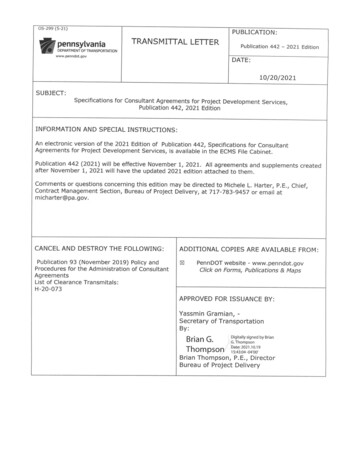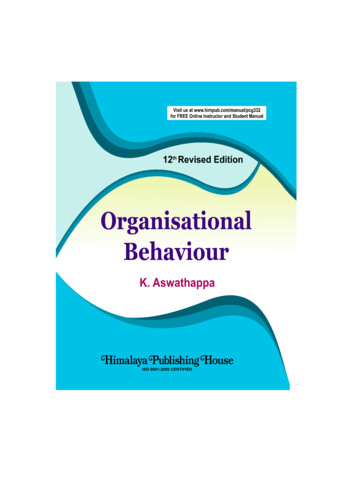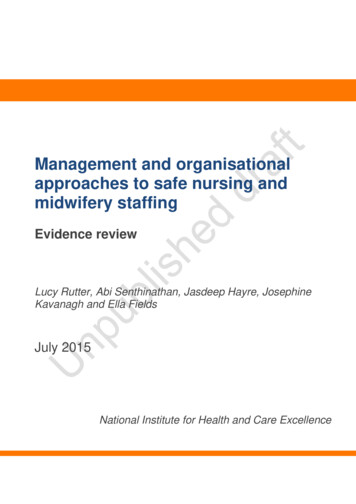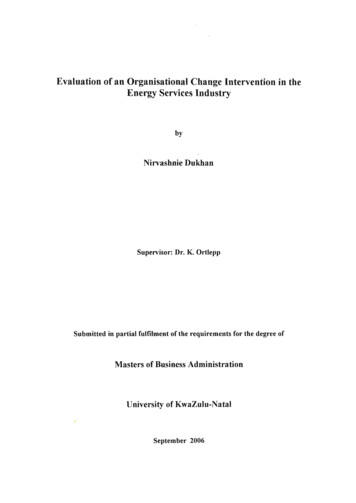
Transcription
Evaluation of an Organisational Change Intervention in theEnergy Services IndustrybyNirvashnie DukhanSupervisor: Dr. K. OrtleppSubmitted in partial fulfilment of the requirements for the degree ofMasters of Business AdministrationUniversity of KwaZulu-NatalSeptem ber 2006
1.2. THE OBJECTIVES OF THIS RESEARCHThe objectives of the research are as follows:1) To establish the nature of the change intervention undertaken by a departmentwithin a large organisation.2) To investigate the process adopted before, during and after the change interventionwith particular reference to the leadership of the process, the key role-players andtheir inputs, the parties affected by the change, how the change process wascommunicated and how it was evaluated.3) To determine whether there was any resistance to the change and how this wasdealt with.4) To explore the factors that hindered and facilitated the process.5) To determine the effectiveness of the organisational change intervention in termsof the organisation's own objectives for the intervention.6) To explore the extent to which the organisational change intervention implementedreflects the principles of current change management models.1.3. SUMMARY OF THE RESEARCH METHODOLOGYThis was a qualitative research study in which in-depth interviews were conducted tounderstand the participants' impressions and experience regarding a change interventionthat affected them and had an impact on their department. The data were collected by indepth interviews and was carried out in the year 2006 at the Pietermaritzburg offices ofthe company selected for the purposes of this study.3
CHAPTER 2:CHANGE MANAGEMENTThis chapter focuses on change management theory and models used to implementchange. The use of best practice principles is highlighted and is pivotal in the context ofthis study.2.1. INTRODUCTIONThe pace and magnitude of change has increased significantly in recent years and this hasfurther contributed to the importance of change management since products and marketsare unstable (Burnes, 2000: 251). In South Africa alone many organisations such asTelkom, Umgeni Water Board, financial institutions and others, have undergone majororganisational changes in response to labour laws and other internal and external factorsin order to remain competitive. According to Slack and Hinings (2004: 15), rapid changeis positive since it creates the momentum required to overcome the inevitable inertia thatbuilds up over time". (Gersick (1991:34) wrote "fundamental change cannot beaccomplished piecemeal, slowly, gradually, or comfortably". The way such changes aremanaged, and the appropriateness of the approach adopted, have major implications forthe way people experience change and their perceptions of the outcome (Ghosn, 2002:44,Hudson, 2001 :45, Christensen and Overdorf, 2000:68).According to Meyerson (2001:94), there appears to be a lot of support for the view thatthe pace of change is accelerating as never before, and that organisations have to charttheir way through an increasingly complex environment. Chawla and Renesch (1995:34)believe that organisations are recognizing the need to acquire and use increasing amountsof knowledge if they are to make the changes necessary to remain competitive since they,for example, have to cope with increasingly challenging and complex situations includingthose where customers and suppliers can be both competitors and allies.5
The Institute of Management, (formerly the British Institute of Management) regularlycarries out surveys of its members and they have found, that their 1997 survey ofmanagers they concluded that "the restructuring that has taken place in UK businesses inthe last 12 months has had a massively negative effect on employee loyalty, morale,motivation and perception of job security" (Worral and Cooper, 1997:33). The 1998survey revealed that , for the majority of respondents, "the impact of restructuring hadbeen to deplete the organisation of people with key skills and experience" (Worrall andCooper, 1998:34). The reality according to these surveys is that organisations can and doexperience severe problems in managing change effectively. Literature on changemanagement has provided evidence and examples of change projects that have gonewrong hence managers have good reason to have doubts about the approach and outcomeof change (Bumes, 2000:252).Change comes in all shapes, sizes and forms and, for this reason; it is difficult to establishan accurate picture of the degree of difficulty organisations face in managing changesuccessfully (LaMarsh, 1995:2; Kegan 2001 :86). According to Bohn (2000:84),haphazardly introduced changes can easily create new problems elsewhere in the changeprocess. The introduction of new technology in the 1980' s; the adoption of Total QualityManagement (TQM) over the last 15 years; and, from the early 1990's; the application ofBusiness Process re-engineering (BPR) were 3 types of organisational changes which, intheir time, were hailed as 'revolutionary' approaches to improving performance andcompetitiveness (Bumes, 2000:252) .The four major types of change that organisationsmay undertake include strategy, structures, technology and people.2.2. CONCEPTUALISING CHANGE MANAGEMENTChange management is not a separate discipline but one that has evolved from a numberof social science disciplines and traditions, which in itself is intertwined with others. It isfor this reason that probing its origins and defining its core concepts is challenging, sinceit overlaps so much, that one may lose clarity and understanding of its essence. Change6
management is about modifying or transforming organisations in order to maintain orimprove their effectiveness (Kirkpatrick, 2001: 3).According to LaMarsh (1995:1), "change management is the methodology that hardwireschange and the ability to adapt into the organisation. It includes applying change-relatedresearch and experience in a systematic way to every business project. It means buildingsystematic thought about change into every business decision. It requires organising thisknowledge about change into a repeatable, teachable framework that is constantly refinedand improved. Changes become an integral part of the way companies work and thespring board for more and constant change". LaMarsh (1995:1) further advocates that"change management is not training. It is not communication. It is not process analysisand re-designs. Change management is a key competency that must be built into the veryfabricof thecompany;a structured methodology thatincorporatestraining,communicating, listening, and process analysis and redesign. It is a way of thinking thatbecomes part of the organisation".There are three schools of thought that this study will highlight that form the foundationof change management theory ,namely, the individual perspective school, the groupdynamics school and the open systems school.It is important to note that organisational behaviour at all its different levels and stages isvery complex. All interactions among the elements or variables within an organisationcannot be monitored or even understood hence the real world is simplified by thedevelopment of different models. This study will focus on selected change managementmodels, which are relevant to establishing the best practice principles within the field ofchange management. Models generally focus on a limited number of key elements orvariables that are seen to offer a good representation of the real world; the ways theseelements interact with each other, sometimes referred to as causal relationships or laws ofeffect and the outputs produced by theses interactions (Hayes, 2002:71).7
Models are developed from personal expenence, either as organisational members orexternal observers of organisational behaviour. Models may be subjective and biasedfocusing only on some aspects of organisational functioning while ignoring others.Models sometimes give a good basis for establishing and understanding what is going onand predicting what kind of actions or interventions would produce a desired change.Models that include explicit reference to outputs offer the possibility of evaluatingperformance and assessing effectiveness (Hayes, 2002:71). It must be emphasized thatchange management models have evolved over time. Change management models weredeveloped and established for different purposes over time.Hayes (2002: 86) briefly lists three characteristics of "good" models namely; they should be relevant to the particular issues under consideration help change agents recognize cause and effect relationships focus on elements that they can influence.Change management models that deal with diagnosing, the fit between an organisationand its environment, include PEST, SWOT and Strebel 's cycle of competitive behaviouramongst others. Change management models that focus on diagnosing an organisation'sinternal alignment are for example Weisbord's six-box organisational model and Pascaleand Athos' 7S model. Models that take the open-systems approach give attention to boththe internal and external environments for example Kotter's integrative model oforganisational dynamics, Nadler and Tushman's congruence model of organisations,Diagnostic Model and the Burke- Litwin causal model of organisational performance andchange (Hayes, 2002:71).According to Anderson and Anderson (2001: 155) the term process can be defined as the"the natural or intentional unfolding of continuous events, within all dimensions ofreality, toward a desired outcome." Change process models are basically tools ofconscious process thinking which are both action orientat ed and results producing. Theyset out the change process so that the transformations desired outcomes are achieved over8
time. Change process models were found to have varying degrees of effectiveness, basedon how accurately and completely they reflect the actual process dynamics oftransformation. A review of the literature and practices of organisational developmentand change management, show that models that are intended to help organisationschange, usually fall into two categories, namely frameworks which are generally staticand process models that are crucial to leading transformations since they demonstrateaction, movement and flow.Change frameworks can be thought of as handy catalogue indexes for selectinginformation and issues relevant to change. They can be useful as planning tools andchecklists according to the literature. The following are good examples of changeframeworks namely McKinsey's 7-S Framework (Peters & Waterman, 1982:126),Weisbord's Six Box Model (1978), Miles'Framework for leading CorporateTransformation (1997) and Three Elements of a Comprehensive Change strategy Model(Ackerman Anderson & Anderson, 1996: 124) since they identify content, people andprocess.Current change process models include Conner's Cycle of Change (1998), Nadler andTushmans's Congruence Model (1977), Nadler's Cycle of Change (1998) and Kotter'sEight Stage Process of Creating Major change (1996). This study will provide in-depthdetails on the following models: Kotter's Eight Stage Process of Creating Major change(1996), the Diagnostic Model (1995) and Nadler and Tushmans's Congruence Model(1977).2.2.1. Differentiation of the roles of manager and leaderTraditionally managers' roles were planning, organising deciding, acting and reviewing.Managers focused on improving organisational performance by focusing on solvingproblems. When a change occurred, it was "commonly developmental, geared towardsimproving what was already in place". (Anderson and Anderson, 2001: 182). Accordingto Anderson and Anderson (2001: 182), managers focused internally (down and in)whereas leaders focused outside the boundaries (up and out) of the organization. While9
managers plan for the short term, leaders have long-term strategic focus. Leaders createstrategic direction, set priorities and satisfy customers. Leaders give more attention thanmanagers to motivating and inspiring people (Anderson and Anderson, 2001: 182).Anderson and Anderson (2001: 187) portrays a continuum of roles from a manager to achange leader. The roles of changer leader is to : Change strategy to integrate people, processes and content needs, which includeschanging mindset and culture to support the organization Setting the foundations for success up-front, designing the change andimplementing it Model and "promote the Emerging Mindset and way of being in the organization" Make sure that "the change is aligned and integrated with all interdependentsystems and processes" Harness people's commitment and contribution to the change Create and sustain the change effort Create organizational capacity for ongoing change.According to Anderson and Anderson (2001: 186), the magnitude of developmentrequired "for a manager to grow into a conscious change leader capable of leadingtransformation, is astounding". Some of the paradigm shifts include the following: Changing from responsible for managing defined entities to being responsible forresponding to massive uncertainties Delegating change to others to leading the change oneself Move "from treating people as cost structures who work to serve the leaders'wishes to caring for peoples' feelings, personal needs and choices" Expecting others to change to engaging in changing oneself Changing from screening and hiding information to sharing all informationopenly to all role-players From mechanizing the change to nurturing the "conditions for change to emergein a complex living system.10
The next section deals with the thinking that underpin the foundation of changemanagement theory.2.3. SCHOOLS OF THOUGHT THAT FORM THE FOUNDATION OF CHANGEMANAGEMENT THEORYThere are three dominant schools of thought, namely, the individual perspective school ,the group dynamics school and the open systems schools of thought and is discussed inthis section.2.3.1. The individual perspective schoolThe promoters of this school are divided into two main groups namely the Behaviouristsand the Gestalt-Field psychologists. The Behaviourists theory states that all behaviour islearned and is a result of an individual's interaction with their environment (Skinner,1974:153). Pavlov (1927:23) conducted an experiment whereby a dog was conditionedto salivate when a bell was rung because the dog associated the sound of the bell withfood. Behaviourists believe that human actions are conditioned by their expectedconsequences hence behaviour that has pleasant results will probably be repeated, whilebehaviour that has unpleasant results will probably not.According to the work of Skinner (1974: 154), for behaviour to change it is necessary tochange the conditions that cause it. The reinforcement theories are based on behaviourmodification, which is basically a systematic effort to shape the behaviour of people(Smit and Cronje , 1997:320) . A specific behaviour can be encouraged, by rewarding(positi ve reinforcement) individuals as they move closer to the desired behaviour.Behaviour can also be reinforced by the avoidance of undesirable consequences (Smitand Cronje , 1997:320). Punishment and extinction are two kinds of negativereinforcement. Punishment is used to discourage undesirable behaviour so that it will notbe repeated . The principle of extinction occurs when a particular behaviour, which waspreviously, rewarded eventually stops if it is not rewarded. The Behaviourists believe that11
organisational change can be achieved mainly by changing the external stimuli actingupon the individual.Gestalt-Field psychologists argue that an individual 's behaviour is the product ofenvironment and reason . French and Bell (1984: 140) explain: "Gestalt therapy is basedon the belief that persons function as whole, total organisms. And each person possessespositive and negative characteristics that must be 'owned up to ' and permittedexpression. People get into trouble when they get fragmented, when they do not accepttheir total selves . Basically one must come to terms with one self. . must stop blockingoff awareness, authenticity and the like by dysfunctional behaviours."Consequently the advocates of the Gestalt-Field perspective seek to "help individualmembers of an organisation change their understanding of themselves and the situation inquestion, which , they believe, in turn will lead to changes in behaviour" (Smit andCronje , 1997:319).Both groups in the Individual Perspective School have proved influentialIIIthemanagement of change.2.3.2.The Group Dynamics SchoolAccording to this school of thought organisational change is brought about through teamsor work groups rather than individuals since people in organisations work in groupshence an individual's behaviour will be shaped by the group's practices and norms. Theindividual is constrained by group pressures to conform . Lewin (1947:24) argued thatgroup behaviour is an intricate set of symbolic interactions and forces, which not onlyinfluence group structures, but also mould individual behaviour. Hence individualbehaviour is a function of the group 'field' as he termed it. According to Lewin (1947:24)an individual 's behaviour at any point in time is an interplay between the intensity andvalence (whether the force is positive or negative) of the forces acting on the person.Arising from this he explains that a group is never in a "steady state of equilibrium" but12
IS IIIa continuous process of mutual adaptation, which he termed "quasi-stationeryequilibrium" (Lewin, 1947:24).The Group Dynamics School promoters believe that the way to bring about change is tofocus on influencing and changing a group's norms, roles and values. Norms are rules orstandards that define what people should do, think or feel in a given situation. The groupdynamics school carefully differentiates between implicit and explicit norms since theformer plays a crucial role in dictating the actions of group members. Explicit norms areformal , written rules, which are known by and applicable to all. Implicit norms are morepowerful since they are informal and unwritten, and individuals may not even beconsciously aware of them.Roles are patterns of behaviour to which individuals and groups are expected to conform,Job descriptions and performance targets are the tools used for roles to be formallydefined in an organisation. However , norms and values also influence roles of individualsor groups. Both individuals and groups have many different roles to play hence it isimportant that roles are clearly defined and compatible to prevent stress at the individuallevel and lack of cohesion at the group level.Values are ideas and beliefs which individuals and groups hold about what is right andwrong. Values are more abstract than norrns or roles because group members are notalways consciously aware of or can easily articulate the values that influence theirbehaviour since it goes beyond what people do, think, or feel in a given situation. Despitethis values are important in determining and changing patterns of behaviour.According to French and Bell (1984: 127), the importance of teams by the followingstatement, " . . the most important single group of interventions in OD [ OrganisationalDevelopment] are team-building activities, the goals of which are the improved andincreased effectiveness of various teams within the organisation. The . . team-buildingmeeting has the goal of improving the teams effectiveness through better management of13
task demands, relationship demands, and group processes. [The team] analyses its wayof doing things and attempts to develop strategies to improve its operation."The Group Dynamics School has played a major part in developing the theory andpractice of change management despite its limited focus.2.3.3. The Open Systems SchoolThe open systems school deals with organisations as a whole. This school is of the viewthat organisations consist of a number of interconnected subsystems whereby a change toone part of the system will affect other parts of the system and in turn its overallperformance. This approach to change describes and evaluates these subsystems in aneffort to establish how they need to be changed so that the overall functioning of anorganisation is improved. The main focus is on "achieving overall synergy rather than onoptimizing the performance of anyone individual part per se" (Mullins, 1989 cited inBurnes 2000:262).According to this school, organisations are not systems in isolation but rather 'open'systems, which are able to interact with their external environments as well internally tothe various subsystems (Hellriegel , Slocum and Woodman, 1998:580). The sub-systemsof the organisation are essentially six interacting and highly interdependent variablesnamely people, culture, task, technology, design and strategy. A change in anyone ofthese variables usually results in a change in one or more of the others, for example achange in an organisation's strategic plan may force the organisation design to beadaptive or network form and this could trigger changes in technology, the need for thereassignment of people, attitudes and behaviours of people etc. (Hellriegel et al,1998:581). One of the benefits of the open systems approach to organisational change isthat it requires all stakeholders to think through interrelationships (Hellriegel et ai,1998:581).14
These theoretical perspectives have contributed to the development of the differentchange models which will be discussed in the review below. A detailed analysis of eachmodel strongly indicates incorporation of the various aspects of these perspectives forexample The Burke-Litwin (1992:126) causal model of organisational performance andchange was derived from the central idea of the open systems perspectives which dealswith the organisation as a whole.2.4. REVIEW OF CHANGE MANAGEMENT MODELSThere are numerous models that will be discussed in this section, namely, the KurtLewins three step model of change, Schein's three stage model of the changeprocess, the incremental model of change, the punctuated equilibrium model oforganisational transformation, the continuous transformation model of change,diagnostic model for managing change, Kotter's (1980) integrative model oforganisational dynamics, Kotter's eight stage process of creating major change(1996), Nadler and Tushmans's (1980) congruence model and the Burke -Litwin(1992) causal model of organisational performance and change.2.4.1 . Kurt Lewins three step Model of ChangeLewin (1958: 197) first depicted the change process as occurring in three stages namely: unfreezing movmg refreezingThe unfreezing stage involves the process of getting people to accept that change isinevitable and to stop doing certain things that resist change (e.g., clinging to a currentpolicy practice or behaviour). The moving stage involves the process of getting people toaccept the new, desired state (e.g., new policies and practices). The last stage refreezinginvolves making the new practices and behaviours a permanent part of the operation orrole expectations (Lewin, 1958: 197).15
Lewin viewed change as being derived from two forces namely internally driven (from aperson's own needs) and forces induced by the environment (Lewin, 1958:197;Desimone, Werner and Harris, 2002:567). Environmental forces were further divided intodriving forces (pushing for change) and restraining forces (those seeking to maintain thestatus quo). Driving forces must outnumber restraining forces for a change to be imposed(Lewin, 1958: 198).2.4.2. Schein's three stage model of the change processSchein (1987: 93) further delineated each stage of Lewin's model as represented in Table2. The essence of Schein 's change model is on the dynamics of individual change andhow a change agent must be able to manage these changes. The change agent motivatesthe person to accept change by "disconfirming his or her attitudes, behaviours orperformance" at stage l(unfreezing); for example, for an employee to correct poor workhabits, he or she must first accept his or her performance is inappropriate.Table 2.1: Schein's three stage model ofthe change processStage 1Unfreezing - Creating motivation and readiness to change through :a. Disconfirmation or lack of confirmationb. Creation of guilt or anxietyc. Provision of psychological safetyStage 2Changing through cognitive restructuring - Helping the individual tosee, judge, feel and react differently based on a new point of viewobtained through:a. Identifying with a new role model, mentor and so onb. Scanning the environment for new relevant informationStage 3Refreezing - Helping the individual to integrate the new point of viewinto:a. His or her total personality and self conceptb. Significant relationshipsSchein (1987:93)16
Stage 2 (changing through cognitive restructuring) is about getting the employee to seeand do things differently and" to actually believe that by changing work habits , his or herperformances will improve". (Schein, 1987: 93). Stage 3 (refreezing) this is when thechange agent helps the person to integrate those new behaviours (work habits) into his orher " thought patterns" in order to "reconfirm his or her self -concept and reinforce thedesired performance standards" (Schein (1987: 93).2.4.3. The incremental model of changeChange is viewed as a process whereby individual parts of an organisation dealincrementally and separately with one problem and one goal at a time (Burnes,2000:254). This means that the change is implemented in one part of an organisation insmall steps and in isolation from other parts and this could impact adversely on costs,customer service and competitive advantage for the organisation.(Stace and Dunphy 1994:534).As Miller and Friesen (1984 :222) state: "The incrementalist perspective on change hasbeen around a relatively long time. It stems from the work of Lindblom (1959: 134), Cyertand March (1963:78), and was further developed by Hedberg et al (1976:45) andespecially Quinn (1980:5 and 1982:615). Quinn argues that strategic change is bestviewed as 'muddling through with purpose, using a continuous, evolving and consensusbuilding approach.Japanese compames have extensively and repeatedly used the incremental model ofchange in order to remain competitive. Dunphy and Stace (1992:54) believed that theincremental model of change could be used by Western companies however they arguedfor a form of managed incrementalism since it avoids both the stagnation caused by finetuning and the brutality of rapid and major corporate transformations.17
2.4.4. The punctuated equilibrium model of organisational transformation.According to Romanelli and Tushman (1994: 1141), "the punctuated equilibrium modelof organisational transformation depicts organisations as evolving through relatively longperiods of stability (equilibrium periods) in their basic patterns of activit y that arepunctuated by relatively short bursts of fundamental change (revolutionary periods) .Revolutionary periods substantively disrupt established activity patterns and install thebasis for new equilibrium periods."This model was introduced to challenge Charles Darwin's gradualist model of evolutionin the natural sciences which led to Gould (1989 :112) to put a case for a punctuatedequilibrium model of evolution; and to explain that "whilst most organisations seem to fitthe incrementalist model of change for a period of time, there does come a point whenthey go through rapid and fundamental change" (Gersick, 1991:34, Amis, 2004:20).Although the punctuated equilibrium model is associated with the work of Miller andFriesen (1984:67); Romanelli and Tushman (1985:86);Gersick (1991:34), "littleresearch has explored the empirical validity of the models basic argument" (Romanelliand Tushman 1994:1142).2.4.5. The continuous transformation model of changeThe advocates of this model believe that for an organisation to survive, it needs todevelop the ability to change continuously and in a fundamental manner in response tothe rapidl y changing environment in which it operates. It is through continuoustransformation that organisations will be able to align themselves with their environmentand remain competitive.Brown and Eisenhardt (1997:1) explain the continuous transformation model of changeby the following statement, " For firms such as Intel, Wal-mart, 3M, Hewl ett-Packardand Gillette, the ability to change rapidly and continuously, especiall y in developin g newproducts, is not only a core competence, it is also at the heart of their cultures. For these18
firms, change is not the rare, episodic phenomenon described by the punctuatedequilibrium model but rather it is endemic to the way these organisations compete.Moreover, in high-velocity industries with short product cycles and rapidly- shiftingcompetitive landscapes , the ability to engage in rapid and relentless continuous change isa crucial capability for survival ." The continuous transformation model was establishedas a third kind of process that was neither incremental nor did it fit into the concept of thepunctuated equilibrium model.Brown and Eisenhardt (1997:29) further promote the continuous transformation model byusing the analogy of complex systems in nature : "Like organisations, complex systemshave large numbers of independent yet interacting actors. Rather than ever reaching astable equilibrium, the most adaptive of these complex systems (for example , intertidalzones) keep changing continuously by remaining at the poetically termed ' edge of chaos'that exists between order and disorder. By staying in this intermediate zone, thesesystems never quite settle into a stable equilibrium but never quite fall apart. Rather,these systems which stay constantly poised between order and disorder, exhibit the mostcomplex and continuous
management is about modifying or transforming organisations in order to maintain or improve their effectiveness (Kirkpatrick, 2001: 3). According to LaMarsh (1995:1), "change management is the methodology that hardwires change and the ability to adapt into the organisation. It includes applying change-related
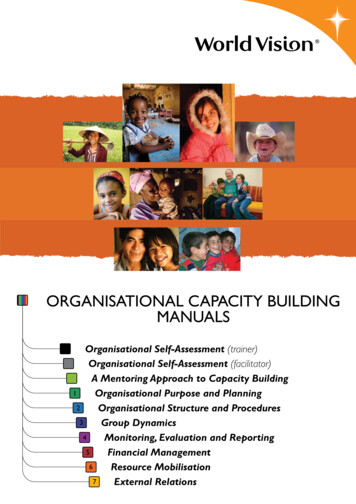

![Change Management Process For [Project Name] - West Virginia](/img/32/change-20management-20process-2003-2022-202012.jpg)



